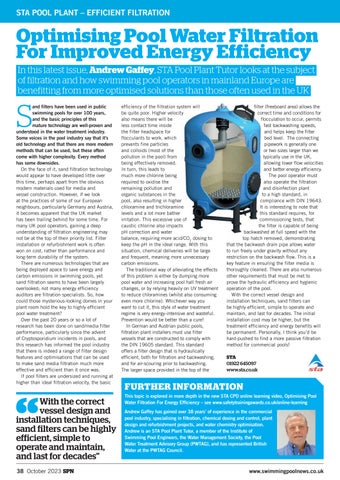STA POOL PLANT – EFFICIENT FILTRATION
Optimising Pool Water Filtration For Improved Energy Efficiency In this latest issue, Andrew Gaffey, STA Pool Plant Tutor looks at the subject of filtration and how swimming pool operators in mainland Europe are benefitting from more optimised solutions than those often used in the UK
S
and filters have been used in public swimming pools for over 100 years, and the basic principles of this mature technology are well-proven and understood in the water treatment industry. Some voices in the pool industry say that it’s old technology and that there are more modern methods that can be used, but these often come with higher complexity. Every method has some downsides. On the face of it, sand filtration technology would appear to have developed little over this time, perhaps apart from the obvious modern materials used for media and vessel construction. However, if we look at the practices of some of our European neighbours, particularly Germany and Austria, it becomes apparent that the UK market has been trailing behind for some time. For many UK pool operators, gaining a deep understanding of filtration engineering may not be at the top of their priority list. Filter installation or refurbishment work is often won on cost, rather than performance and long-term durability of the system. There are numerous technologies that are being deployed apace to save energy and carbon emissions in swimming pools, yet sand filtration seems to have been largely overlooked; not many energy efficiency auditors are filtration specialists. So, how could those mysterious-looking domes in your plant room hold the key to highly efficient pool water treatment? Over the past 20 years or so a lot of research has been done on sand/media filter performance, particularly since the advent of Cryptosporidium incidents in pools, and this research has informed the pool industry that there is indeed a range of filter design features and optimisations that can be used to make sand media filtration much more effective and efficient than it once was. If pool filters are undersized and running at higher than ideal filtration velocity, the basic
With the correct vessel design and installation techniques, sand filters can be highly efficient, simple to operate and maintain, and last for decades” 38 October 2023 SPN 38_SPN_October_2023_STA.indd 38
efficiency of the filtration system will be quite poor. Higher velocity also means there will be less contact time inside the filter headspace for flocculants to work, which prevents fine particles and colloids (most of the pollution in the pool) from being effectively removed. In turn, this leads to much more chlorine being required to oxidise the remaining pollution and organic substances in the pool, also resulting in higher chloramine and trichloramine levels and a lot more bather irritation. This excessive use of caustic chlorine also impacts pH correction and water balance, requiring more acid/CO2 dosing to keep the pH in the ideal range. With this situation, chemical deliveries will be large and frequent, meaning more unnecessary carbon emissions. The traditional way of alleviating the effects of this problem is either by dumping more pool water and increasing pool hall fresh air changes, or by relying heavily on UV treatment to reduce chloramines (whilst also consuming even more chlorine). Whichever way you want to cut it, this style of water treatment regime is very energy-intensive and wasteful. Prevention would be better than a cure! In German and Austrian public pools, filtration plant installers must use filter vessels that are constructed to comply with the DIN 19605 standard. This standard offers a filter design that is hydraulically efficient, both for filtration and backwashing, and for air-scouring prior to backwashing. The larger space provided in the top of the
filter (freeboard area) allows the correct time and conditions for flocculation to occur, permits fast backwashing speeds, and helps keep the filter bed level. The connecting pipework is generally one or two sizes larger than we typically use in the UK, allowing lower flow velocities and better energy efficiency. The pool operator must also operate the filtration and disinfection plant to a high standard, in compliance with DIN 19643. It is interesting to note that this standard requires, for commissioning tests, that the filter is capable of being backwashed at full speed with the top hatch removed, demonstrating that the backwash drain pipe allows water to run freely under gravity without any restriction on the backwash flow. This is a key feature in ensuring the filter media is thoroughly cleaned. There are also numerous other requirements that must be met to prove the hydraulic efficiency and hygienic operation of the pool. With the correct vessel design and installation techniques, sand filters can be highly efficient, simple to operate and maintain, and last for decades. The initial installation cost may be higher, but the treatment efficiency and energy benefits will be permanent. Personally, I think you’d be hard-pushed to find a more passive filtration method for commercial pools! STA 01922 645097 www.sta.co.uk
FURTHER INFORMATION This topic is explored in more depth in the new STA CPD online learning video, Optimising Pool Water Filtration For Energy Efficiency – see www.safetytrainingawards.co.uk/online-learning Andrew Gaffey has gained over 38 years’ of experience in the commercial pool industry, specialising in filtration, chemical dosing and control, plant design and refurbishment projects, and water chemistry optimisation. Andrew is an STA Pool Plant Tutor, a member of the Institute of Swimming Pool Engineers, the Water Management Society, the Pool Water Treatment Advisory Group (PWTAG), and has represented British Water at the PWTAG Council.
www.swimmingpoolnews.co.uk 08/10/2023 22:28
